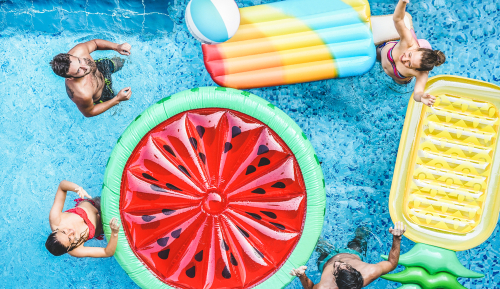What started as a week to raise awareness about water safety in 2003 has now evolved into a month-long event to help prevent water-related fatalities, illnesses, and injuries known as National Water Safety Month. According to the Centers for Disease Control and Prevention (CDC), drowning is the fifth leading cause of unintentional injury death, and more than 50% of drowning victims require hospitalization. Unfortunately, many drowning victims are children who lack the ability to swim. National organizations use May as a time to highlight the importance of learning to swim and handle water emergencies through PSAs, educational literature, and more.
"National Water Safety Month is a powerful way to send a crucial message at the start of the busy summer swim season," said Connie Harvey, Director of the Aquatics Centennial Initiative for the American Red Cross. "There are layers of protection involved in water safety. Ensuring everyone in the family learns how to swim and that parents and caregivers have the knowledge and skills to handle emergencies around the water, including how to perform CPR is a good place to start. National Water Safety Month helps us communicate these messages."
To prevent an accident and resulting injuries and fatalities, it’s important for individuals to be water competent, and know how to respond quickly in case of emergency. Being prepared can save lives.
Factors that Increase Risk of Drowning
There are many factors that can increase the risk of drowning for individuals, not just the inability to swim.
Common factors that can lead to a water-related accident include:
- Alcohol use
- Failure to wear life jacket or flotation devices (especially for young children)
- Lack of qualified or attentive supervision, including lifeguards and babysitters
- Seizure disorders
- Lack of barriers such as unlocked areas or lack of pool covers
What Is Water Competency?
Water competency is comprised of three main components that need to be understood to improve water safety for yourself and those around you. By having basic water competency skills, you may be able to prevent dangerous situations or even save lives if needed.
The three components of water competency include:
- Water smarts: When you’re around water, it’s important to never swim alone – make sure others are present in case you require assistance. Water smarts also include knowing to swim sober, knowing your own physical and medical limitations, and understanding water risks such as river currents and ocean rip currents.
- Swimming skills: Everyone with water competency should know how to float or tread water, as well as be able to swim at least 25 yards. This should be able to be executed in all water environments, including swimming pools, oceans, lakes, and rivers.
- Helping others: In a water environment, it’s important to pay close attention to any children or weak swimmers who are in or near water. You must also be able to understand when a person is drowning and know how to best assist them. CPR and first aid knowledge are also crucial.
Signs of Drowning
In order to be water competent and help prevent drowning accidents, you need to be aware of the signs of drowning, as you can’t expect someone who’s drowning to easily get your attention.
Signs of drowning to look out for include:
- Eyes glassy and empty, or entirely closed
- Head low in the water with mouth at water level
- Hair that’s flopped over a person’s forehead or eyes
- Trying to roll over onto back without success
- Hyperventilating or gasping
- Not using legs
Drowning individuals may not always be able to wave their hands and call for help when they’re drowning. If you suspect someone may be struggling, the best way to help them is to approach them and ask them if they’re okay. If they say “no” or don’t answer, alert a lifeguard or professional who can safely rescue the individual and begin administering first aid or CPR.
Millions of Dollars Recovered for Victims of Swimming Pool Accidents
Water-related accidents, especially those involving drowning, often take a huge toll on those affected – physically, emotionally, and financially. Fatalities often leave families feeling helpless and burdened with debts including funeral costs and lost income if they’d previously depended on the victim. In the cases where victims do survive their accidents, they can be left with long-term or permanent injuries, like brain damage, that require lifelong medical care families may not be prepared to pay for. At The J. Guerra Law Firm, we want to alleviate your fears by fighting for the compensation you deserve after an accident caused by negligence. We can’t undo your accident, but we can help to cover your costs and prepare you for a better future.
If you or someone you love has fallen victim to a swimming pool accident, call The J. Guerra Law Firm today at (877) 903-8323, or contact us online. Our swimming pool safety lawyer has helped countless drowning victims and those who have been injured in water-related accidents, and can pursue the compensation you deserve to heal.


